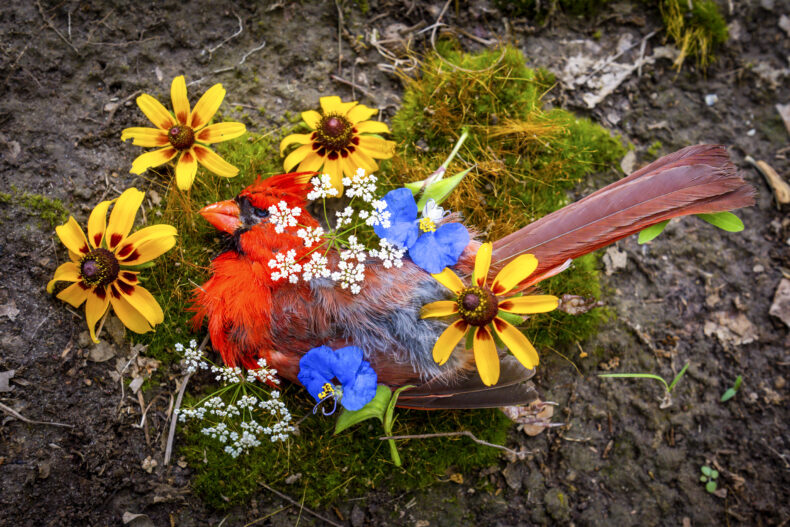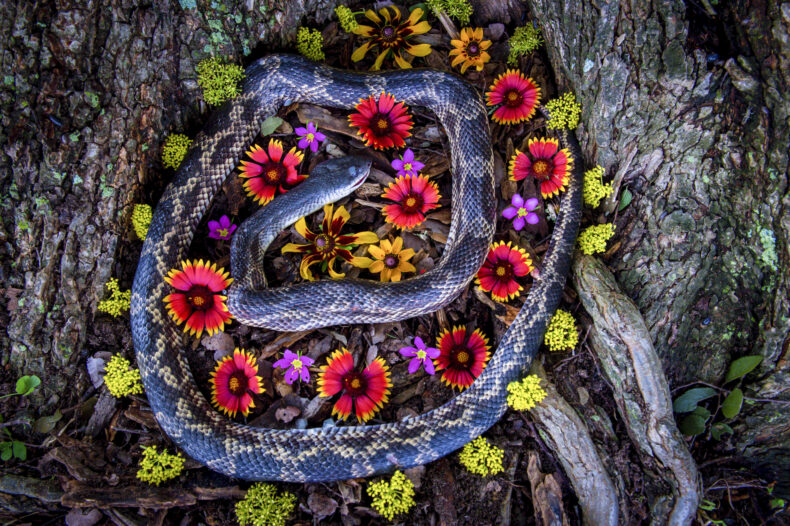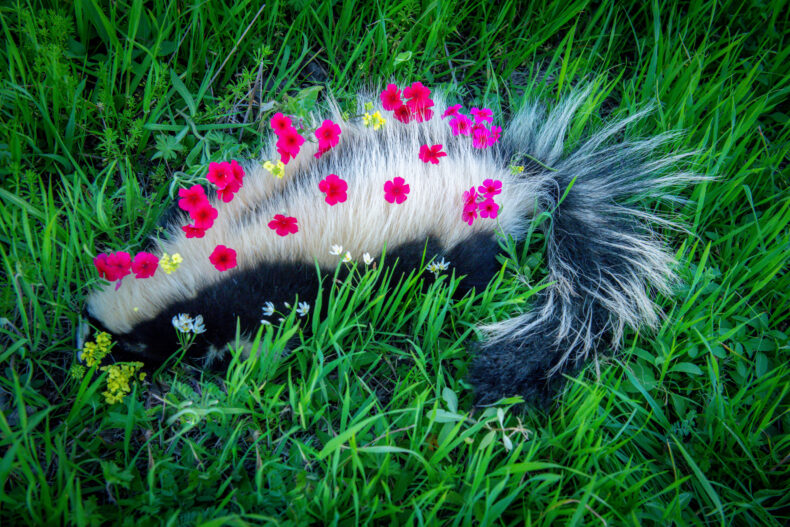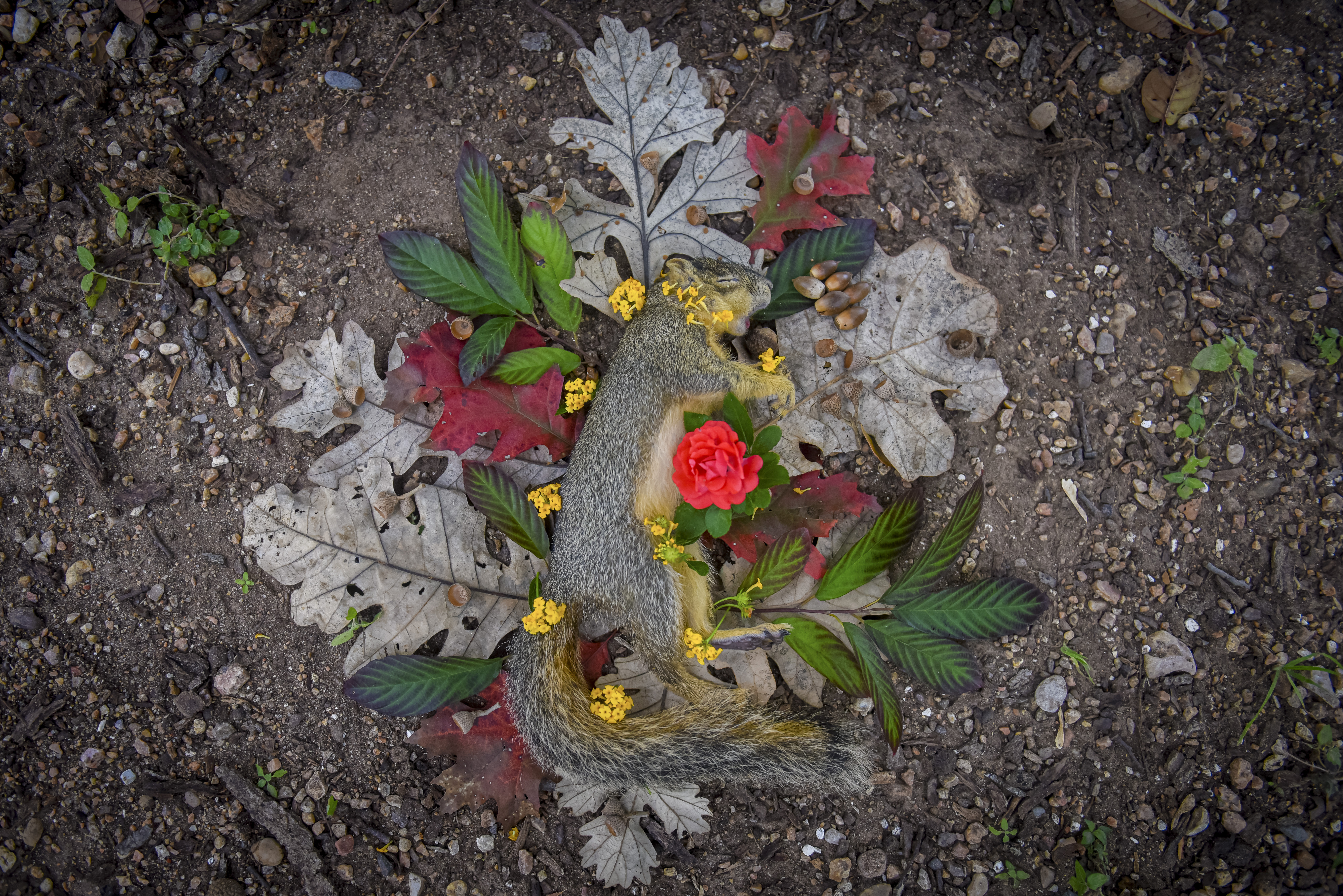
Amanda Stronza found the cardinal dead on a Texas highway this June, a splash of vermillion against drab asphalt. He’d been struck by a car—a common fate for birds, as many as 340 million of whom are killed by vehicles in the United States every year. Most drivers overlook these casualties, but not Stronza, an environmental anthropologist at Texas A&M University. She scooped up the cardinal and conveyed him to a quiet place, where she laid him atop moss and covered him with flowers. “His little body weighed nothing…” she wrote when she posted a photo of the bright, tasteful tableau on Instagram. “I’m sorry, beautiful one.”
The paradox of roadkill is that it’s at once conspicuous and invisible: Our highways are lined with so many crushed raccoons and pulverized opossums that we hardly notice them. Stronza’s artistic mission is to make us see the wild deaths humans both inflict and ignore. I first stumbled upon Stronza’s roadkill photography while researching my book Crossings, and was struck by how her unflinching portraits negotiate the difficult balance of celebrating animal lives while lamenting their deaths. “It’s like serving as a witness, or giving a eulogy,” Stronza told me recently. “In that way, I hope that we can be more sensitive to the lives of the animals who share our communities with us.”

Stronza began memorializing animals in 2019, when she found a dead squirrel in downtown Austin. “What struck me in that moment were all the people just streaming past that animal, like she was nothing,” Stronza recalled. She encircled the squirrel with flowers and pinecones, snapped a photo, and published her impromptu tribute on social media, where it went viral. She’s since created memorials for dozens of creatures, including porcupines, skunks, coyotes, turtles, armadillos, and snakes. In the Kalahari Desert this summer, she commemorated a honey badger; in Nepal, she memorialized a langur. She covers wounds with flowers and rocks—not to airbrush death, but to maintain her subjects’ dignity, a practice and ethic that reminds me of the care morticians take in preparing human bodies for open-casket funerals. “I’m always looking for beauty,” she said.
The emphasis on beauty is a quietly radical choice in a culture that either disregards roadkill or mocks it. The sociologist Dennis Soron has observed that, when it doesn’t ignore roadkill altogether, capitalism transmutes dead animals into commodities that contribute to the victims’ “ritualized abasement” — hence gruesome toys like “Rikki-Tikki Roadkill, a tire-flattened version of Kipling’s fabled mongoose” and RoadKill Kitties “featuring bendable wire tails, missing eyes, and carefully stitched-in ‘road damage.’” The sociologist Mike Michaels has noted that cartoons usually endow roadkilled animals with a “stereotypical stupidity signified by cross-eyes, buck-teeth, and sticky-out tongue,” a perverse form of victim-blaming. Stronza’s work subverts these cruel paradigms: The animals in her portraits are elegant and unmarred, yet their eerie stillness reminds us of the awful finality of their deaths and the routine nature of automotive violence.

Although there’s no official manual for creating tributes to dead animals, Stronza has a few tips for would-be memorialists. She keeps old blankets and towels in her car, so that she can safely handle bodies without touching feathers or fur, and only stops for carcasses that aren’t too grisly or decomposed—and that she can handle without endangering her own safety. Less important than the memorials themselves, she said, is the spirit that animates them. “If everybody stopped for dead animals, we’d be causing havoc,” she pointed out. “My larger concern is that we acknowledge the animals who have been killed and not look away from them. Maybe we can say I’m sorry or I see you as we’re driving.”
To Stronza’s surprise, her project has inspired a global audience. She’s amassed more than 48,000 Instagram followers, and estimates that kindred spirits have sent her a thousand memorials of their own, from butterflies to wallabies. Her art has also drawn attention to her academic research, which examines how people interact with wildlife; in Botswana, for example, she helps farmers humanely manage conflicts with crop-raiding elephants. Like many conservationists, she’s devoted to protecting animal populations, yet her photography also conveys the importance of respecting individual lives.
“I want us to see not just all squirrels, but this squirrel,” Stronza says. “Maybe the memorials are an entry point for talking about bigger conservation challenges.”

Photos: Amanda Stronza
Weirdly interesting. Fascinating. I would never have the time it would take to memorialize the road kill that exists on Helton but I will at least acknowledge it from now on!
I do acknowledge dead animals when I see them on the road, and whenever possible I move them from further damage. I have been following Amanda for a bit now. It makes me feel good to know that someone else sees these wonderful creatures!